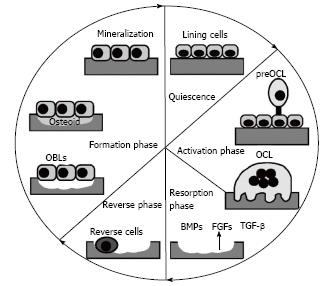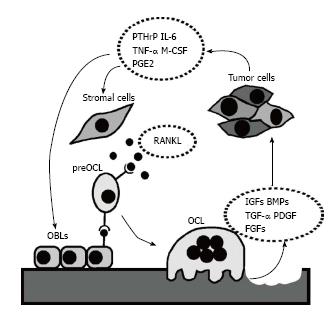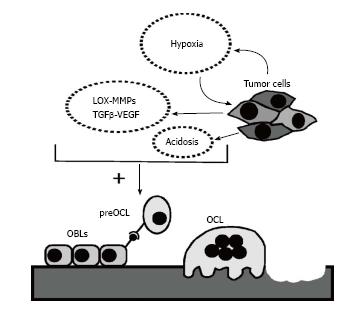Copyright
©2014 Baishideng Publishing Group Inc.
World J Clin Oncol. Aug 10, 2014; 5(3): 335-347
Published online Aug 10, 2014. doi: 10.5306/wjco.v5.i3.335
Published online Aug 10, 2014. doi: 10.5306/wjco.v5.i3.335
Figure 1 Phases of bone remodeling.
Starting from the quiescence phase, bone remodeling is triggered by different stimuli that lead to activation of lining cells, which increase surface expression of receptor activator of nuclear factor kappa-B ligand (RANKL). This cytokine, by binding to its receptor RANK, promotes osteoclast differentiation (activation phase). Next, mature osteoclasts resorb bone (resorption phase), thus allowing the release of factors usually stored in the bone matrix (BMPs, TGF-β and FGFs) that recruit osteoblasts in the reabsorbed area. Once recruited, osteoblasts form the bone matrix and ensure its mineralization (formation phase), completing the bone remodeling process. BMPs: Bone morphogenetic proteins; TGF-β: Transforming growth factor-β; FGFs: Fibroblast growth factor; OCL: osteoclast; OBL: osteoblast.
Figure 2 Schematic representation of the vicious cycle.
Under physiologic conditions, osteoblasts produce factors that regulate osteoclastogenesis (RANKL/OPG). Mature osteoclasts erode the bone matrix, allowing the release of factors (IGF-1, BMPs, TGF-β, PDGF, and FGFs). Tumor cells perturb this homeostasis by producing factors (PTHrP, IL-6, TNF-α, M-CSF, and PGE2) that favor osteoclastogenesis, with subsequent bone resorption and release of the growth factors stored in the bone matrix, which in turn enhance tumor growth. BMPs: Bone morphogenetic proteins; TGF-β: Transforming growth factor-β; FGFs: Fibroblast growth factor; IGFs: Insulin-like growth factors; PDGF: Platelet-derived growth factor; M-CSF: Macrophage colony stimulating factor; PGE2: Prostaglandin E2; OCL: osteoclast; OBL: osteoblast.
Figure 3 Potential pro-metastatic role of hypoxia in bone.
Hypoxia stimulates targeting of cancer cells to bone and facilitates their survival within the bone microenvironment. The presence of a hypoxic environment, further sustained by cancer growth, induces the secretion of hypoxia-inducible factors by cancer cells. These factors, in conjunction with parallel acidification of the microenvironment, are associated with osteoclastogenesis. TGF-β: Transforming growth factor-β.
- Citation: Rucci N, Sanità P, Monache SD, Alesse E, Angelucci A. Molecular pathogenesis of bone metastases in breast cancer: Proven and emerging therapeutic targets. World J Clin Oncol 2014; 5(3): 335-347
- URL: https://www.wjgnet.com/2218-4333/full/v5/i3/335.htm
- DOI: https://dx.doi.org/10.5306/wjco.v5.i3.335











